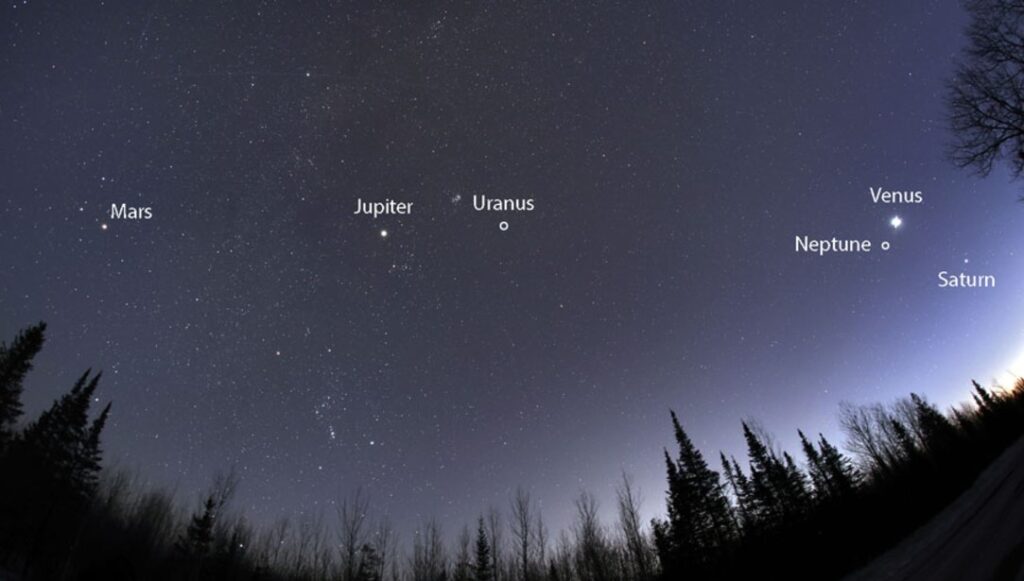Contents:
Introduction
February 2025 is set to be an exciting month for stargazers and astronomy enthusiasts. With a lineup of planets and eye-catching celestial alignments, there will be plenty to observe in the night sky. This blog post will guide you through the planetary events and celestial phenomena you can expect to see this month, ensuring you don’t miss out on any of the spectacular sights.
Planetary Lineup
February 2025 will feature a stunning lineup of moon planets visible in the night sky. Here’s a look at the key planetary events:
1. Mercury: Mercury will be visible in the pre-dawn sky throughout the month. Look towards the eastern horizon just before sunrise to spot this elusive planet. Mercury will reach its greatest elongation west on February 16, making it an excellent time to observe it.

Images : Sky & Telescope
2. Venus: The bright evening star, Venus, will dominate the western sky after sunset. Venus will be at its greatest eastern elongation on February 22, shining brilliantly and providing a spectacular sight for stargazers.
3. Mars: Mars will be visible in the evening sky, gradually moving westward throughout the month. The Red Planet will be close to Venus in the sky, creating a beautiful pairing that will be a treat to observe.
4. Jupiter: Jupiter will be visible in the early morning sky, rising in the east before dawn. The gas giant will be at its best for observation in the second half of the month, as it climbs higher in the sky.
5. Saturn: Saturn will also be visible in the pre-dawn sky, rising shortly before Jupiter. Its iconic rings make it a favorite target for amateur astronomers.
Eye-Catching Alignments
February 2025 will feature several notable alignments and conjunctions that will make for some memorable stargazing moments:
1. Venus and Mars Conjunction (February 13): One of the highlights of the month will be the close conjunction of Venus and Mars. The two planets will appear less than one degree apart in the western sky after sunset. This close approach will create a striking visual spectacle that you won’t want to miss.
2. Moon, Jupiter, and Saturn (February 20-21): In the early morning hours of February 20-21, the crescent moon will pass close to Jupiter and Saturn, creating a picturesque alignment. This will be a great opportunity to capture stunning photographs of the trio.

Images : Akira Fujji
3. Mercury and Crescent Moon (February 17): Just before sunrise on February 17, look towards the eastern horizon to see Mercury and the slender crescent moon close together. This beautiful pairing will be a delightful sight for early risers.
4. Lunar Occultation of Uranus (February 5): On February 5, the moon will pass in front of Uranus, temporarily obscuring it from view. This event, known as a lunar occultation, will be visible from certain parts of the world and is a rare opportunity to see this distant planet.
5. Neptune at Opposition (February 26): Neptune will be at opposition on February 26, meaning it will be directly opposite the sun in the sky and at its brightest for the year. This is the best time to observe Neptune, though a telescope will be needed to see this distant ice giant.
Meteor Showers and Other Celestial Events
In addition to the planetary alignments, February 2025 will also feature some meteor showers and other celestial events:
1. Alpha Centaurids Meteor Shower (February 8-9): The Alpha Centaurids are an annual meteor shower that peaks in early February. While not as prolific as some of the more famous meteor showers, it can still produce some bright meteors. The best time to observe will be after midnight.
2. Full Snow Moon (February 24): The full moon in February is known as the Snow Moon. This will be a great opportunity to observe the moon in all its glory, especially if you have a telescope or binoculars to see its craters and surface features.
3. Zodiacal Light: For those in the Northern Hemisphere, February offers a good chance to see the zodiacal light. This faint, triangular glow is caused by sunlight reflecting off interplanetary dust particles and is best seen in a dark sky after sunset.
Tips for Observing the Night Sky
To make the most of your stargazing experience in February 2025, consider the following tips:
1. Find a Dark Location: Light pollution can hinder your ability to see faint objects in the sky. Find a location away from city lights for the best viewing experience.
2. Use Binoculars or a Telescope: While many of the planets and alignments will be visible to the naked eye, using binoculars or a telescope can enhance your observations and reveal more details.
3. Check the Weather: Clear skies are essential for stargazing. Check the weather forecast before heading out to ensure optimal viewing conditions.
4. Know the Timing: Many celestial events occur at specific times. Plan your stargazing sessions around the times when the planets and alignments are best visible.
5. Bring a Star Map: A star map or astronomy app can help you identify the planets and constellations in the sky, making your stargazing experience more enjoyable.
Historical Significance of Planetary Alignments
Planetary alignments have fascinated humans for centuries. Ancient civilizations often interpreted these celestial events as omens or messages from the gods. In modern times, while we understand the scientific basis of these alignments, they still capture our imagination and inspire awe.
For example, the conjunction of Venus and Mars has been a symbol of romantic love and passion in various cultures. The close approach of these two planets in February 2025 can be seen as a celestial celebration of love, coinciding with Valentine’s Day.
Technological Advances in Observing the Sky
In recent years, technological advancements have revolutionized the way we observe and understand the night sky. High-resolution telescopes, sophisticated imaging equipment, and powerful astronomy software have made it possible for amateur astronomers to capture breathtaking images and make significant contributions to our knowledge of the cosmos.
In February 2025, take advantage of these technologies to enhance your stargazing experience. Many astronomy apps provide real-time tracking of celestial events, making it easier to locate and observe the planets and alignments. Additionally, sharing your observations and photographs on social media platforms can connect you with a community of fellow astronomy enthusiasts.
Conclusion
February 2025 promises to be an exciting month for stargazers, with a lineup of planets and eye-catching alignments that will make for some unforgettable nights under the stars. From the conjunction of Venus and Mars to the picturesque alignment of the moon, Jupiter, and Saturn, there will be plenty to observe and enjoy.
Remember to find a dark location, use binoculars or a telescope, and check the weather for optimal viewing conditions. With a bit of preparation and a sense of wonder, you’ll be able to experience the beauty and majesty of the night sky.
Happy stargazing!
Also Check : Interactive Sky Chart

